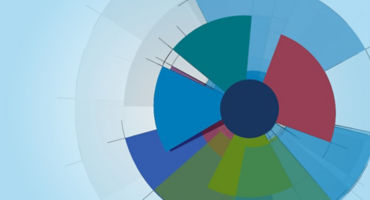Another difference in the current environment is that we’re seeing concentration not just at the individual stock level but also at the sector, style, and factor levels. In the late 1960s and early 1970s, markets were concentrated in a limited number of stocks, but those stocks were widely diversified by sector. Think of companies like GE, GM, Exxon, AT&T, Kodak, and IBM. Today’s leaders have a strong bent toward technology and growth.
Adam: As I noted, we’ve actually seen some of the mega-cap tech companies lag the market to begin 2025. With that said, do you expect this current period of concentration to continue, or could we begin to see some meaningful broadening?
Andy: I think this concentration could persist as long as those exceptional fundamentals that I mentioned persist. At a basic level, relative price and returns follow relative growth of profits and free cash flow over time. One question I often get is, “Can the mega-cap tech companies continue to grow faster than average?” Over short periods, that’s certainly possible. Over the longer term, though, the mathematics of averages will catch up with them.
A related factor is investor expectations. Over the last couple of years, the mega-cap tech companies have consistently exceeded current expectations, while future expectations have continued to ratchet higher. Interestingly, however, Q4 2024 was the first period over the past two years in which their results stayed mostly in line with expectations — in other words, they didn’t exceed expectations. And forward consensus expectations did not change after Q4. So it may be that investor expectations have finally caught up with the fundamentals.
Of course, most investors would welcome some broadening of growth across the rest of the equity market. It’s stunning to think that over the past two years, the earnings growth of the entire US equity market was driven by just seven companies. But we’re starting to see some positive signs in this respect. In Q4, the S&P 500 ex the Mag Seven delivered EPS growth of 7%. And when I talk to allocators, there’s a growing recognition that this exceptionalism around the mega-cap tech stocks is feeling a little long in the tooth. Maybe it can continue for a bit longer, but it may not be too early to be looking more broadly for opportunities on the other side.
Adam: Are there any takeaways from prior periods of market concentration that indicate how conditions might reverse?
Andy: It's a mixed bag. As I noted, market leadership during the late 1960s and early 1970s period was much more diversified than the current period, so the ways in which it unwound were varied, including regulatory and competitive forces and technological change. The late 1990s may be a better point of comparison, as the market was heavily driven by technological innovation amid the internet boom. The market leaders at the time were, in many cases, not the companies that ultimately succeeded. In an era of innovation, the long-term winners might only be in their infancy or may not even yet exist. It’s also worth remembering that if the technology is really a game changer, the impact will eventually be felt broadly in terms of economic productivity and market returns.
Adam: So, looking back on this latest period of market concentration, what are some of the takeaways or lessons asset owners should be thinking about?
Andy: From a practical risk-management perspective, one of the big takeaways is that active managers need to be just as aware of their active underweights as their active overweights. That’s especially important in a very narrow market: If a manager is underweight a stock by 300 basis points, there should be the same level of conviction in that position as there would be in one with an overweight of 300 basis points.
I also think asset owners should be taking a fresh look at portfolio diversification. The saying goes that the only free lunch in investing is diversification, but in recent years, that’s a meal that has induced a lot of indigestion. Holding almost anything other than mega-cap tech has been a drag on returns and added to risk and volatility. That said, I think we're moving back into an environment where diversification matters. We’re seeing less synchronization of cycles across economies, making it more important to understand the level of diversification across a portfolio. That requires thinking not just about direct exposure to the mega-cap stocks, but also the “thematic” exposure to those stocks. When the DeepSeek news broke earlier this year, it wasn’t just Nvidia that took a hit. There was a big drawdown in data-center stocks and others tied to the AI trade. So, it’s important to understand correlations across exposures and what that means for overall diversification.
Interestingly, while we've had this very narrow market, the past five years have also brought a sharp increase in equity market dispersion — a measure of the range of outcomes between the winners and losers. It’s been evident across individual stocks globally, but also between and within sectors. This is attractive for active managers who can identify those winners and losers, and I think it helps explain why we have seen improved performance from long/short managers, including traditional hedge funds and extension (130/30 or 140/40) approaches.
Adam: Can you talk a bit more about extension strategies and any other portfolio ideas you think asset owners should consider?
Andy: Extension strategies are at the top of my list when it comes to navigating narrow markets. Being able to express an active view through both long and short investments can provide valuable flexibility when the market is as concentrated as what we see in Figure 1. For a long-only manager, it's hard to express an active underweight with a stock that has a single-digit basis point weight in the index. But extension strategies can address this by using short exposure to fund more long exposure. This gives the manager more flexibility to own the largest benchmark names at a market-cap weight if they do not have a differentiated view on the companies, while still allowing them to be highly active in the remainder of their opportunity set.
I also think asset owners might want to consider “index completion” approaches that use passive allocations to big benchmark weights to essentially neutralize them — helping to hedge the risk of being underweight the big names and put the focus on the managers’ high-conviction stock-selection ideas.












Monthly Market Review — February 2025
Continue readingBy
Brett Hinds
Jameson Dunn